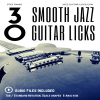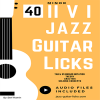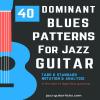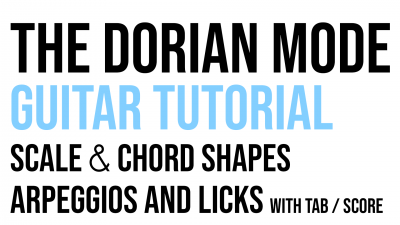
How to Practice Pentatonic Scales On Guitar
- By jazz-guitar-licks
- On 2019-06-01
- 0 comments
Pentatonic scales are scales with five notes per octave. They are frequently used in music all over the world. The word "pentatonic" comes from the Greek word "pente" meaning five and "tonic" meaning tone.
Talk of "the" pentatonic scale generally make reference to the major pentatonic scale and its relative minor. It's a mistake, indeed there are many types of pentatonic scales (Egyptian, Ritusen, Man gong, Altered, Locrian...).
Pentatonic scales are considered earlier than heptatonic scales (seven-note scales) and can be divided into two categories :
- Containing semitones (hemitonic)
- Without semitones (anhemitonic)
The purpose of this post is to propose some tips and ideas for practicing and develop pentatonic scales.
Major and Minor Pentatonic Scales
How to Play Major and Minor Pentatonic Scales?
The best known are surely the major pentatonic and the minor pentatonic scales (also known as "the relative minor pentatonic"). They do not have semitones they belong to the anhemitonic family. They contain the same notes, for every major scale, there is a relative minor scale and for every minor scale there is a relative major.
- Relative minor scales begin on the sixth degrees of major scales.
- Relative major scales begin on the third degree of minor scales.
Let's take an example with C major pentatonic (C - D - E - G - A). It has the same notes as the A minor pentatonic (A - C - D - E - G). The sixth degree of C major pentatonic is the tonic of A minor pentatonic scale.
Now another example with the G minor pentatonic scale (G-Bb-C-D-F). The relative major pentatonic starts on the third degree of G minor. Thus giving the Bb pentatonic scale (Bb-C-D-F-G).
Pentatonic Scale Boxes
What Are pentatonic Boxes?
Major and minor Pentatonic scales are commonly grouped in five positions named "boxes" corresponding to the five pentatonic modes of the major pentatonic scale. Learning these "boxes" can be useful when you want to cover all the guitar neck. Here they are :
Pentatonic One Octave Shapes
However, the most efficient way to master pentatonic scales is to play them in "one octave shapes" and transpose them in the twelve keys. Any guitar student must be able to play any pentatonic scale in one-octave shapes starting on any string at any fret. This also applies to every scale.
Major Pentatonic One-octave Shapes
How to Develop Pentatonic Scales?
Now that you are familiar with the common pentatonic shapes both major and minor, we will see how to develop them on the guitar neck.
4 Directions
Many beginner guitarists used to practice scales in two directions only, generally "up-up" and "down-down". It is a good place to begin. However, it is important to practice them in all four directions :
- Up & up
- Up & down
- Down & down
- Down & up
You must be able to play the major and minor pentatonic scales (and any other scale) in all four directions using the one-octave shape diagrams previously seen. This is an excellent warm up exercise.
The Cycle of Fifths
Now you can try to play pentatonic scales following the circle of fifths. The circle of fifths is a useful device when you want to practice  scales, chords or arpeggios over the 12 keys.
scales, chords or arpeggios over the 12 keys.
Generally it is presented in the form of a circular diagram that shows the sharps and flats in each key, and show how a key works in relation to one another. You can check the interactive circle of fifths by Rand Scullard.
The first example below, show you how to play the major pentatonic scale following the circle of fifths in up & up movement, whereas the second is up & down.
You need to do the same down & up and down & down with both minor and major pentatonic scales.
The Cycle of Fourths
 The circle of fourths is also great for practicing scales, chords and arpeggios. It is very efficient to learn about the guitar neck and give the student a solid intuition of chord progressions.
The circle of fourths is also great for practicing scales, chords and arpeggios. It is very efficient to learn about the guitar neck and give the student a solid intuition of chord progressions.
This is the relationship between the twelve notes of the chromatic scale. Every note resolves to another note a fourth above it. In other words, by following the circle of fourths, you play all the notes separated from each other by five semitones (a fourth).
While the cycle of fifths moves from left to right, if you move from right to left, then you have the cycle of fourths.
So now, try to play the major and minor pentatonic scales following the circle of fourths in all four directions (up & up, down & down, up & down, down & up).
Other Intervals
Another good way to practice the pentatonic scales consist to play them by intervals (seconds, thirds, sixths and sevenths) following once again the four directions previously seen. You can check out this page that lists the intervals.
Here is an example of major pentatonic scales played in intervals of minor thirds (Three semitones).
Melodic Patterns
A melodic pattern is a repetitive sequence or a figure that can be used with any scale. Melodic patterns are very useful for learning scale fingerings and develop your sense of improvisation. The concept is simple, the variations endless.
The principle is to play the notes of a scale in a certain order. For example, with the C major pentatonic scale which is C-D-E-G-A :
- C is the I degree (1)
- D is the II (2)
- E the III (3)
- G the V (5)
- A the VI (6)
You can choose to play the pattern 1-3-2-5-6 thus giving the following exercise :
Now, try another pattern : 2-3-1-5-6
The possibilities are endless. Now that you have understood the principle, try to create your own melodic patterns by playing them in intervals following the four directions.
Please note that all these exercises can be applied to any scale. Don't forget to vary the rhythm and the fingerings on the guitar neck in order to create your own exercises.
-
Guitar Scale Dictionary
This E-book is a printable PDF method including over 700 scale diagrams and formula charts for guitarists. -
Guitar Chord Dictionary
This PDF eBook provides over 550 guitar chord shapes. This is the perfect reference guide to understand how chords are built and how to play them on the guitar neck. -
30 Groovy Jazz Guitar Licks
This downloadable package contains a PDF WITH audio files giving access to 30 groovy guitar phrases mixing jazz, blues and funky licks for beginners. -
172 Arpeggio Shapes For Guitar
This printable PDF is a method dedicated to guitarists of all styles who want to learn build and play the most important types of arpeggios. -
126 Triad Chord Shapes
This handbook for guitar players is intended both for teachers and students. It includes 126 guitar shapes for mastering triads. -
Harmonic Major Scale Chords
this PDF offers diagrams and tabs for guitar to learn the chords of the harmonic major scale. -
Major Scale Harmonization
This package provides a printable PDF with exercises and audio files to learn how to harmonize the major scale with 3 note chords and their extensions. -
30 Minor Arpeggio Licks
This package includes a printable PDF method containing 30 exercises with tabs, staves and audio files for practicing minor arpeggios on guitar. -
II V I Bundle - 170 Exercises
This bundle contains 4 PDF methods for a total of 170 exercises with tabs, staves, analysis & audio files for practicing scales, arpeggios licks & chords over the 2-5-1 progression. -
Diatonic Licks Bundle
This package contains 120 jazz guitar lines based on diatonic modes as Mixolydian, Dorian and Ionian. PDF format with tabs, audio files and analysis. -
30 Smooth Jazz Guitar Licks
In this package you'll get a printable PDF Method with tabs, notation, analysis, scale shapes and audio files for practicing 30 smooth jazz guitar licks. -
40 II V I Jazz Guitar Licks
This pdf method for guitar contains fourteen 2 5 1 jazz guitar lines with tab, standard notation, analysis, scale charts and audio files. -
50 II-V-I voicings
This printable PDF guitar method provides 50 exercises with audio files, analysis, tab and staves for learning major 2-5-1 chord voicings. -
40 Minor 2 5 1 Chord Voicings
This PDF method contains 40 exercices with tabs, scores and audio files for practicing jazz guitar chords over the minor 2 5 1 progression. -
40 Minor II V I Licks
This guitar method is a printable PDF with tabs, diagrams, theory and audio files providing 40 minor 2 5 1 jazz patterns. -
40 Mixolydian Jazz Guitar Lick
PDF guitar method with tabs, audio files and theory providing 40 dominant jazz guitar lines for teachers and students. -
40 Minor Jazz Guitar Licks
This printable guitar method in PDF format contains 40 easy minor jazz guitar lines based on the Dorian mode. -
40 Major Jazz Guitar Licks
Printable PDF eBook method containing 40 major jazz guitar licks with tab, standard notation and audio files for beginners and intermediates. -
Guitar Walking Bass Lines
This jazz guitar method about walking bass lines and chords is available as a PDF files containing 35 exercises with tabs, analysis and audio files -
101 Dominant Arpeggio Patterns
This printable PDF method provides 101 dominant arpeggio exercises with tab, theory and standard notation for the jazz, blues and rock guitarist. -
49 Essential Jazz Lines
This printable eBook method in PDF format provides 49 jazz solo transcriptions of the greatest jazz musicians. Tab, standard notation, audio files & analysis. -
11 Jazz Blues Studies
11 jazz blues chord studies with tabs, standard notation, analysis, and audio recordings and PDF. -
10 Easy Fingerstyle Blues
This PDF with Tabs and audio files provides 10 easy acoustic fingerstyle blues guitar studies for kids and beginners. -
25 Altered Jazz Guitar Lines
This PDF eBook method contains 25 altered jazz guitar licks with tabs, patterns, scale charts and audio files to master, apply and develop the altered scale. -
40 Blues Dominant Patterns
This printable method is available as a PDF file containing 40 easy dominant jazz-blues guitar lines with tabs, standard notation, analysis, audio files and scale charts. -
25 Pentatonic Licks
This jazz guitar method is an eBook available as a PDF with standard notation, guitar tabs, diagrams, analysis, audio files and backing tracks. You will find in this booklet 25 easy jazz guitar lines with theory using common and rare pentatonic scales. -
25 Soul Jazz Guitar Licks
You will find here an eBook available in PDF containing 25 soul jazz and hard bop guitar licks in the style of Grant Green, Melvin Sparks, George Benson. -
25 Diminished Patterns
This eBook PDF with audio files contains 25 dominant diminished jazz guitar patterns using the half-whole diminished scale and diminished 7th arpeggios. -
6 Tritone substitution licks
This Printable PDF eBook available for free download contains 6 easy jazz guitar licks with tabs/notation, youtube video link and analysis about the tritone substitution. -
10 Minor 7 Arpeggio Patterns
This printable PDF eBook offers 10 easy minor 7 arpeggio patterns with its related YouTube video for beginner guitarists. -
10 Easy Major 7 Arpeggio Licks
This is a printable PDF for beginner jazz guitar players providing 10 easy licks to practice major 7 arpeggios. -
10 Chord Melody Lines
Within this package, you'll discover a set of ten chord melody exercises for beginners. Printable PDFaudio files, a backing track, and a link to the associated YouTube video. -
10 Minor Blues Scale Licks
You'll find here a PDF with 10 easy jazz guitar licks to practice the minor blues scale on guitar.
guitar scales jazz guitar lesson pentatonic improvisation Theory
Add a comment





























































